Abstract
An enhancement of neurotransmission of serotonin (5-HT), noradrenaline, or both, underlies the antidepressant response associated with most agents presently available to treat major depression. With respect to the 5-HT system, antidepressant drugs exert immediate effects on some neuronal elements controlling overall transmission, but it is the gradual changes in neuronal responses to such treatments that are ultimately responsible for producing their therapeutic benefits. In major depression, an increase in 5-HT1A transmission is thought to be a crucial determinant of the antidepressant response, whereas an enhancement of 5-HT2 transmission in the orbitofrontal cortex may mediate the therapeutic effect of 5-HT reuptake inhibitors in obsessive-compulsive disorder (OCD). The doses of medication and the durations of treatment necessary to obtain these alterations in 5-HT transmission in various brain structures of laboratory animals are fully consistent with the conditions in the clinic necessary to attenuate symptoms in depression and OCD. It is also possible that the relief of chronic pain produced by some antidepressants may be mediated, in part, by the blockade of peripheral 5-HT2A receptors. These observations emphasize the notion that the 5-HT system is endowed with different adaptive properties in various parts of the body, which, in addition to the multiplicity of 5-HT receptors, makes this chemospecific network important in many disorders.
Full text
PDF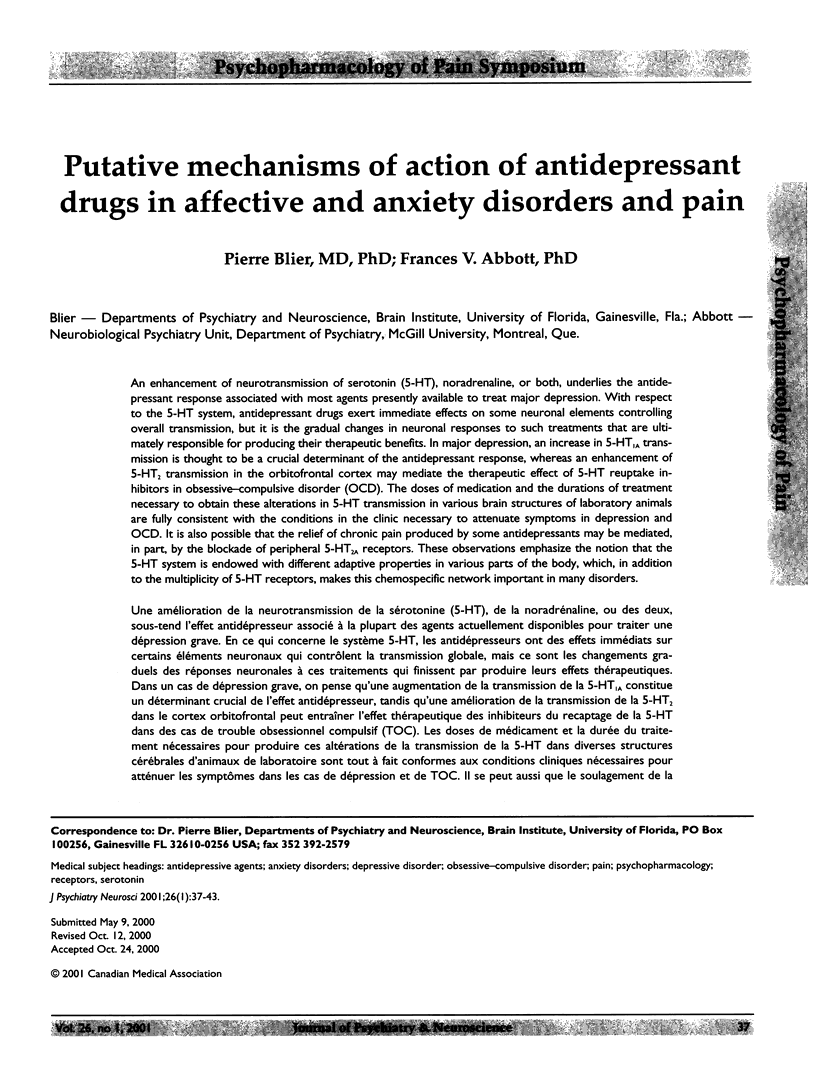
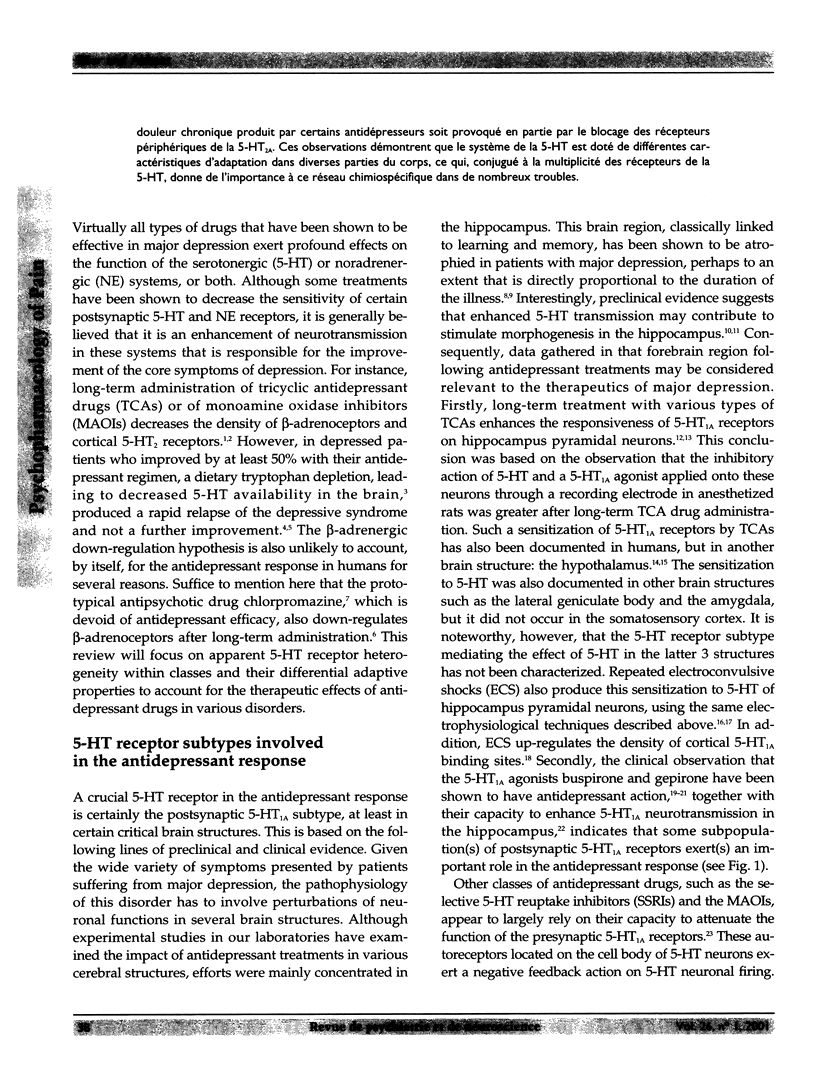
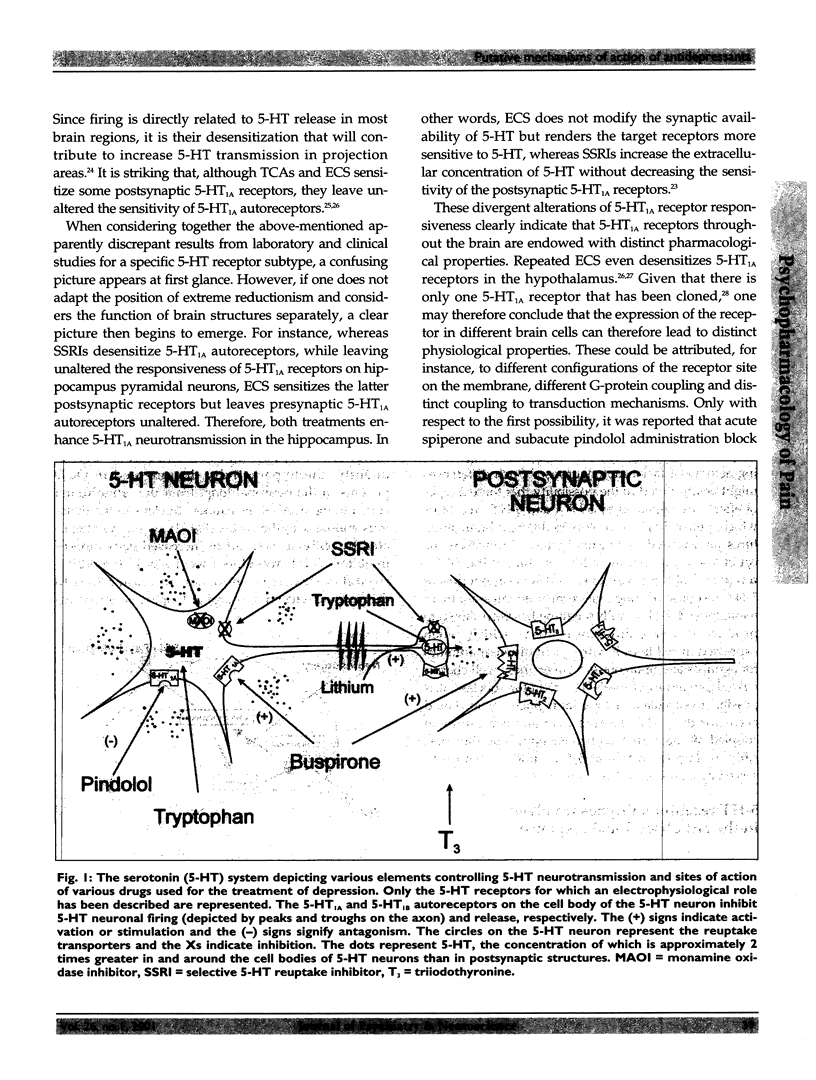
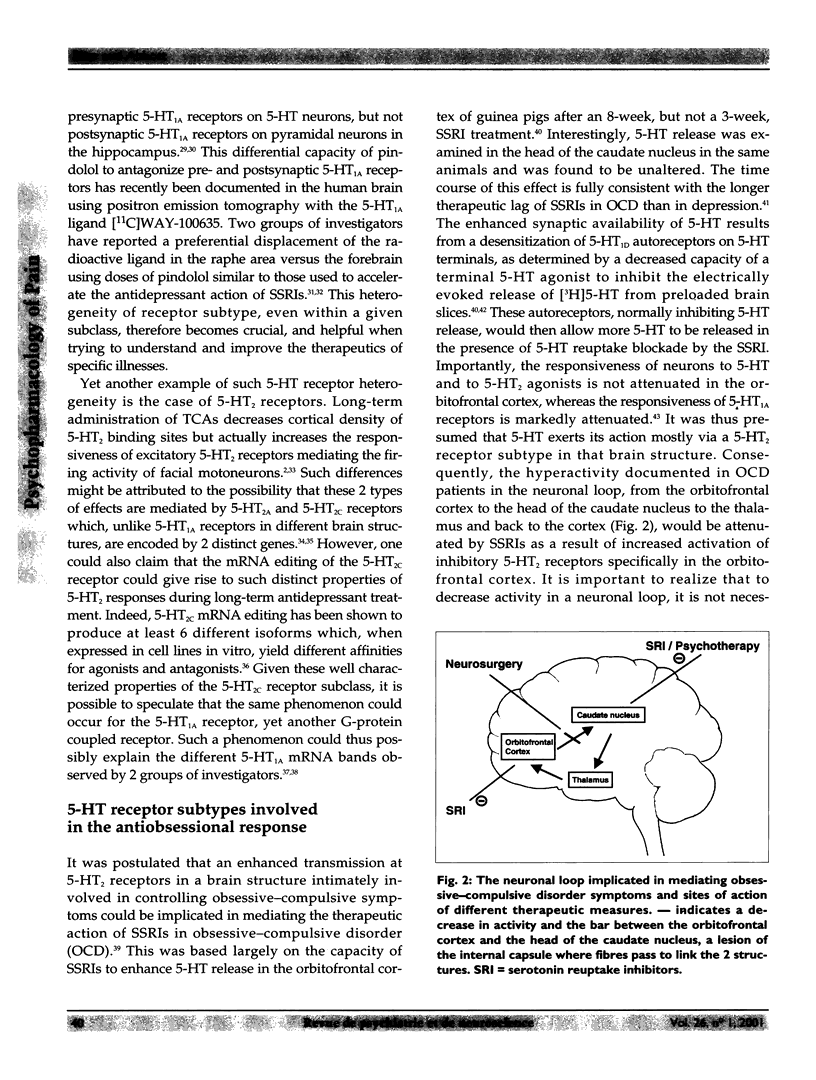


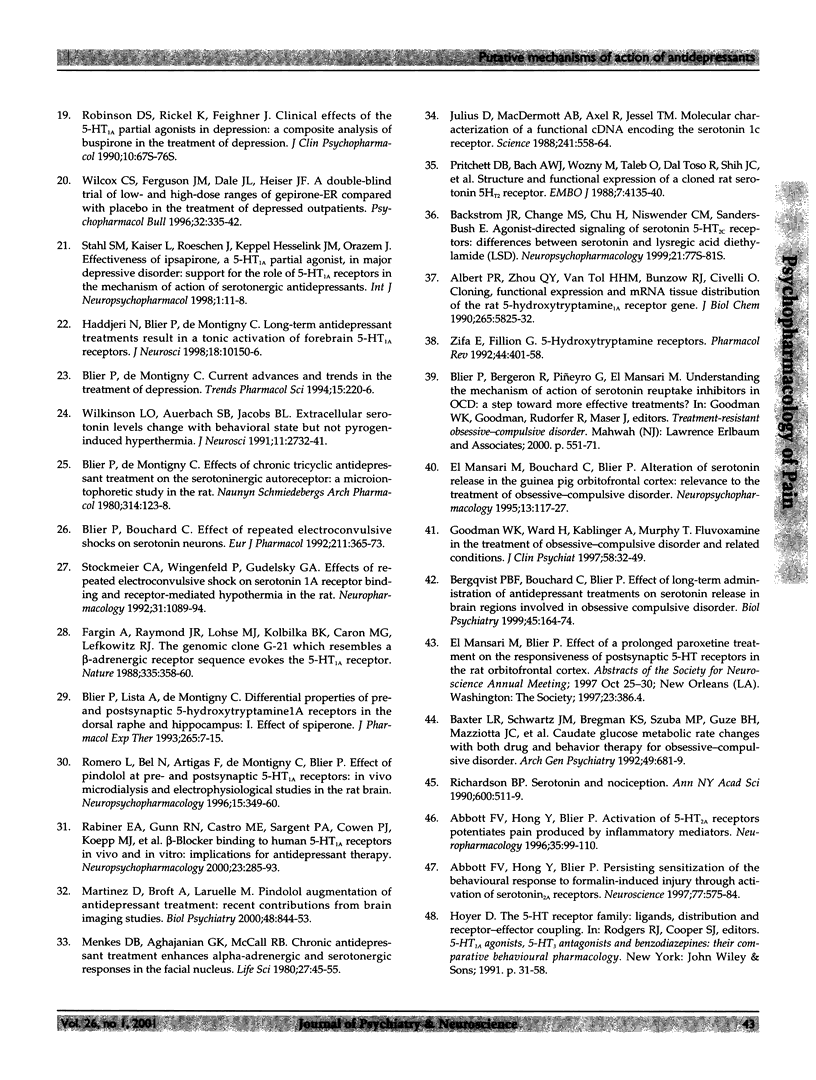
Selected References
These references are in PubMed. This may not be the complete list of references from this article.
- Abbott F. V., Hong Y., Blier P. Activation of 5-HT2A receptors potentiates pain produced by inflammatory mediators. Neuropharmacology. 1996 Jan;35(1):99–110. doi: 10.1016/0028-3908(95)00136-0. [DOI] [PubMed] [Google Scholar]
- Abbott F. V., Hong Y., Blier P. Persisting sensitization of the behavioural response to formalin-induced injury in the rat through activation of serotonin2A receptors. Neuroscience. 1997 Mar;77(2):575–584. doi: 10.1016/s0306-4522(96)00422-8. [DOI] [PubMed] [Google Scholar]
- Albert P. R., Zhou Q. Y., Van Tol H. H., Bunzow J. R., Civelli O. Cloning, functional expression, and mRNA tissue distribution of the rat 5-hydroxytryptamine1A receptor gene. J Biol Chem. 1990 Apr 5;265(10):5825–5832. [PubMed] [Google Scholar]
- Backstrom J. R., Chang M. S., Chu H., Niswender C. M., Sanders-Bush E. Agonist-directed signaling of serotonin 5-HT2C receptors: differences between serotonin and lysergic acid diethylamide (LSD). Neuropsychopharmacology. 1999 Aug;21(2 Suppl):77S–81S. doi: 10.1016/S0893-133X(99)00005-6. [DOI] [PubMed] [Google Scholar]
- Baudry M., Martres M. P., Schwartz J. C. Modulation in the sensitivity of noradrenergic receptors in the CNS studied by the responsiveness of the cyclic AMP system. Brain Res. 1976 Oct 29;116(1):111–124. doi: 10.1016/0006-8993(76)90252-3. [DOI] [PubMed] [Google Scholar]
- Baxter L. R., Jr, Schwartz J. M., Bergman K. S., Szuba M. P., Guze B. H., Mazziotta J. C., Alazraki A., Selin C. E., Ferng H. K., Munford P. Caudate glucose metabolic rate changes with both drug and behavior therapy for obsessive-compulsive disorder. Arch Gen Psychiatry. 1992 Sep;49(9):681–689. doi: 10.1001/archpsyc.1992.01820090009002. [DOI] [PubMed] [Google Scholar]
- Bergqvist P. B., Bouchard C., Blier P. Effect of long-term administration of antidepressant treatments on serotonin release in brain regions involved in obsessive-compulsive disorder. Biol Psychiatry. 1999 Jan 15;45(2):164–174. doi: 10.1016/s0006-3223(98)00154-1. [DOI] [PubMed] [Google Scholar]
- Blier P., Bouchard C. Effect of repeated electroconvulsive shocks on serotonergic neurons. Eur J Pharmacol. 1992 Feb 18;211(3):365–373. doi: 10.1016/0014-2999(92)90394-j. [DOI] [PubMed] [Google Scholar]
- Blier P., Lista A., De Montigny C. Differential properties of pre- and postsynaptic 5-hydroxytryptamine1A receptors in the dorsal raphe and hippocampus: I. Effect of spiperone. J Pharmacol Exp Ther. 1993 Apr;265(1):7–15. [PubMed] [Google Scholar]
- Blier P., de Montigny C. Current advances and trends in the treatment of depression. Trends Pharmacol Sci. 1994 Jul;15(7):220–226. doi: 10.1016/0165-6147(94)90315-8. [DOI] [PubMed] [Google Scholar]
- Blier P., de Montigny C. Effect of chronic tricylic antidepressant treatment on the serotoninergic autoreceptor: a microiontophoretic study in the rat. Naunyn Schmiedebergs Arch Pharmacol. 1980 Nov;314(2):123–128. doi: 10.1007/BF00504527. [DOI] [PubMed] [Google Scholar]
- Bremner J. D., Narayan M., Anderson E. R., Staib L. H., Miller H. L., Charney D. S. Hippocampal volume reduction in major depression. Am J Psychiatry. 2000 Jan;157(1):115–118. doi: 10.1176/ajp.157.1.115. [DOI] [PubMed] [Google Scholar]
- Chaput Y., de Montigny C., Blier P. Presynaptic and postsynaptic modifications of the serotonin system by long-term administration of antidepressant treatments. An in vivo electrophysiologic study in the rat. Neuropsychopharmacology. 1991 Dec;5(4):219–229. [PubMed] [Google Scholar]
- Charney D. S., Heninger G. R., Sternberg D. E. Serotonin function and mechanism of action of antidepressant treatment. Effects of amitriptyline and desipramine. Arch Gen Psychiatry. 1984 Apr;41(4):359–365. doi: 10.1001/archpsyc.1984.01790150049008. [DOI] [PubMed] [Google Scholar]
- Delgado P. L., Charney D. S., Price L. H., Aghajanian G. K., Landis H., Heninger G. R. Serotonin function and the mechanism of antidepressant action. Reversal of antidepressant-induced remission by rapid depletion of plasma tryptophan. Arch Gen Psychiatry. 1990 May;47(5):411–418. doi: 10.1001/archpsyc.1990.01810170011002. [DOI] [PubMed] [Google Scholar]
- Delgado P. L., Miller H. L., Salomon R. M., Licinio J., Krystal J. H., Moreno F. A., Heninger G. R., Charney D. S. Tryptophan-depletion challenge in depressed patients treated with desipramine or fluoxetine: implications for the role of serotonin in the mechanism of antidepressant action. Biol Psychiatry. 1999 Jul 15;46(2):212–220. doi: 10.1016/s0006-3223(99)00014-1. [DOI] [PubMed] [Google Scholar]
- Fargin A., Raymond J. R., Lohse M. J., Kobilka B. K., Caron M. G., Lefkowitz R. J. The genomic clone G-21 which resembles a beta-adrenergic receptor sequence encodes the 5-HT1A receptor. Nature. 1988 Sep 22;335(6188):358–360. doi: 10.1038/335358a0. [DOI] [PubMed] [Google Scholar]
- Goodman W. K., Ward H., Kablinger A., Murphy T. Fluvoxamine in the treatment of obsessive-compulsive disorder and related conditions. J Clin Psychiatry. 1997;58 (Suppl 5):32–49. [PubMed] [Google Scholar]
- Haddjeri N., Blier P., de Montigny C. Long-term antidepressant treatments result in a tonic activation of forebrain 5-HT1A receptors. J Neurosci. 1998 Dec 1;18(23):10150–10156. doi: 10.1523/JNEUROSCI.18-23-10150.1998. [DOI] [PMC free article] [PubMed] [Google Scholar]
- Jacobs B. L., van Praag H., Gage F. H. Adult brain neurogenesis and psychiatry: a novel theory of depression. Mol Psychiatry. 2000 May;5(3):262–269. doi: 10.1038/sj.mp.4000712. [DOI] [PubMed] [Google Scholar]
- Julius D., MacDermott A. B., Axel R., Jessell T. M. Molecular characterization of a functional cDNA encoding the serotonin 1c receptor. Science. 1988 Jul 29;241(4865):558–564. doi: 10.1126/science.3399891. [DOI] [PubMed] [Google Scholar]
- Martinez D., Broft A., Laruelle M. Pindolol augmentation of antidepressant treatment: recent contributions from brain imaging studies. Biol Psychiatry. 2000 Oct 15;48(8):844–853. doi: 10.1016/s0006-3223(00)00993-8. [DOI] [PubMed] [Google Scholar]
- Mazer C., Muneyyirci J., Taheny K., Raio N., Borella A., Whitaker-Azmitia P. Serotonin depletion during synaptogenesis leads to decreased synaptic density and learning deficits in the adult rat: a possible model of neurodevelopmental disorders with cognitive deficits. Brain Res. 1997 Jun 20;760(1-2):68–73. doi: 10.1016/s0006-8993(97)00297-7. [DOI] [PubMed] [Google Scholar]
- Menkes D. B., Aghajanian G. K., McCall R. B. Chronic antidepressant treatment enhances alpha-adrenergic and serotonergic responses in the facial nucleus. Life Sci. 1980 Jul 7;27(1):45–55. doi: 10.1016/0024-3205(80)90018-1. [DOI] [PubMed] [Google Scholar]
- Nishizawa S., Benkelfat C., Young S. N., Leyton M., Mzengeza S., de Montigny C., Blier P., Diksic M. Differences between males and females in rates of serotonin synthesis in human brain. Proc Natl Acad Sci U S A. 1997 May 13;94(10):5308–5313. doi: 10.1073/pnas.94.10.5308. [DOI] [PMC free article] [PubMed] [Google Scholar]
- Nowak G., Dulinski J. Effect of repeated treatment with electroconvulsive shock (ECS) on serotonin receptor density and turnover in the rat cerebral cortex. Pharmacol Biochem Behav. 1991 Mar;38(3):691–694. doi: 10.1016/0091-3057(91)90037-3. [DOI] [PubMed] [Google Scholar]
- Peroutka S. J., Snyder S. H. Long-term antidepressant treatment decreases spiroperidol-labeled serotonin receptor binding. Science. 1980 Oct 3;210(4465):88–90. doi: 10.1126/science.6251550. [DOI] [PubMed] [Google Scholar]
- Piñeyro G., Deveault L., Blier P., Dennis T., de Montigny C. Effect of acute and prolonged tianeptine administration on the 5-HT transporter: electrophysiological, biochemical and radioligand binding studies in the rat brain. Naunyn Schmiedebergs Arch Pharmacol. 1995 Feb;351(2):111–118. doi: 10.1007/BF00169324. [DOI] [PubMed] [Google Scholar]
- Pritchett D. B., Bach A. W., Wozny M., Taleb O., Dal Toso R., Shih J. C., Seeburg P. H. Structure and functional expression of cloned rat serotonin 5HT-2 receptor. EMBO J. 1988 Dec 20;7(13):4135–4140. doi: 10.1002/j.1460-2075.1988.tb03308.x. [DOI] [PMC free article] [PubMed] [Google Scholar]
- Rabiner E. A., Gunn R. N., Castro M. E., Sargent P. A., Cowen P. J., Koepp M. J., Meyer J. H., Bench C. J., Harrison P. J., Pazos A. beta-blocker binding to human 5-HT(1A) receptors in vivo and in vitro: implications for antidepressant therapy. Neuropsychopharmacology. 2000 Sep;23(3):285–293. doi: 10.1016/S0893-133X(00)00109-3. [DOI] [PubMed] [Google Scholar]
- Richardson B. P. Serotonin and nociception. Ann N Y Acad Sci. 1990;600:511–520. doi: 10.1111/j.1749-6632.1990.tb16906.x. [DOI] [PubMed] [Google Scholar]
- Robinson D. S., Rickels K., Feighner J., Fabre L. F., Jr, Gammans R. E., Shrotriya R. C., Alms D. R., Andary J. J., Messina M. E. Clinical effects of the 5-HT1A partial agonists in depression: a composite analysis of buspirone in the treatment of depression. J Clin Psychopharmacol. 1990 Jun;10(3 Suppl):67S–76S. doi: 10.1097/00004714-199006001-00013. [DOI] [PubMed] [Google Scholar]
- Romero L., Bel N., Artigas F., de Montigny C., Blier P. Effect of pindolol on the function of pre- and postsynaptic 5-HT1A receptors: in vivo microdialysis and electrophysiological studies in the rat brain. Neuropsychopharmacology. 1996 Oct;15(4):349–360. doi: 10.1016/0893-133X(95)00240-E. [DOI] [PubMed] [Google Scholar]
- Sheline Y. I., Wang P. W., Gado M. H., Csernansky J. G., Vannier M. W. Hippocampal atrophy in recurrent major depression. Proc Natl Acad Sci U S A. 1996 Apr 30;93(9):3908–3913. doi: 10.1073/pnas.93.9.3908. [DOI] [PMC free article] [PubMed] [Google Scholar]
- Stahl Stephen M., Kaiser Lee, Roeschen Julie, Keppel Hesselink Jan M., Orazem John. Effectiveness of ipsapirone, a 5-HT-1A partial agonist, in major depressive disorder: support for the role of 5-HT-1A receptors in the mechanism of action of serotonergic antidepressants. Int J Neuropsychopharmacol. 1998 Jul;1(1):11–18. doi: 10.1017/S1461145798001059. [DOI] [PubMed] [Google Scholar]
- Stockmeier C. A., Wingenfeld P., Gudelsky G. A. Effects of repeated electroconvulsive shock on serotonin1A receptor binding and receptor-mediated hypothermia in the rat. Neuropharmacology. 1992 Nov;31(11):1089–1094. doi: 10.1016/0028-3908(92)90003-8. [DOI] [PubMed] [Google Scholar]
- Vetulani J., Sulser F. Action of various antidepressant treatments reduces reactivity of noradrenergic cyclic AMP-generating system in limbic forebrain. Nature. 1975 Oct 9;257(5526):495–496. doi: 10.1038/257495a0. [DOI] [PubMed] [Google Scholar]
- Wilcox C. S., Ferguson J. M., Dale J. L., Heiser J. F. A double-blind trial of low- and high-dose ranges of gepirone-ER compared with placebo in the treatment of depressed outpatients. Psychopharmacol Bull. 1996;32(3):335–342. [PubMed] [Google Scholar]
- Wilkinson L. O., Auerbach S. B., Jacobs B. L. Extracellular serotonin levels change with behavioral state but not with pyrogen-induced hyperthermia. J Neurosci. 1991 Sep;11(9):2732–2741. doi: 10.1523/JNEUROSCI.11-09-02732.1991. [DOI] [PMC free article] [PubMed] [Google Scholar]
- Zifa E., Fillion G. 5-Hydroxytryptamine receptors. Pharmacol Rev. 1992 Sep;44(3):401–458. [PubMed] [Google Scholar]
- de Montigny C., Aghajanian G. K. Tricyclic antidepressants: long-term treatment increases responsivity of rat forebrain neurons to serotonin. Science. 1978 Dec 22;202(4374):1303–1306. doi: 10.1126/science.725608. [DOI] [PubMed] [Google Scholar]
- el Mansari M., Bouchard C., Blier P. Alteration of serotonin release in the guinea pig orbito-frontal cortex by selective serotonin reuptake inhibitors. Relevance to treatment of obsessive-compulsive disorder. Neuropsychopharmacology. 1995 Oct;13(2):117–127. doi: 10.1016/0893-133X(95)00045-F. [DOI] [PubMed] [Google Scholar]


